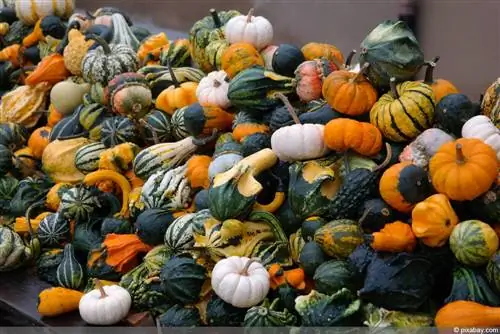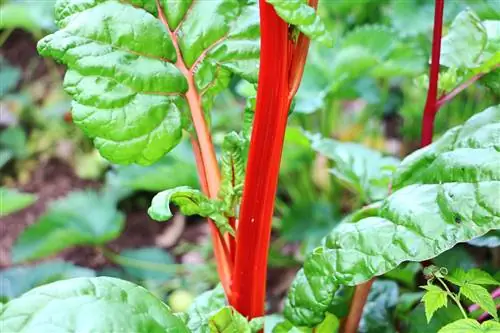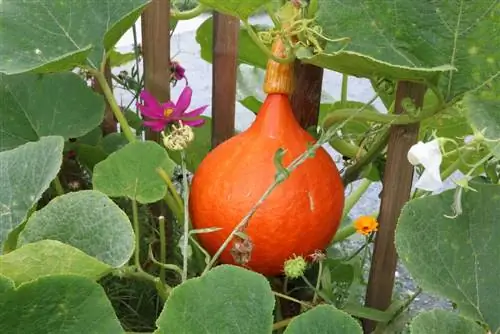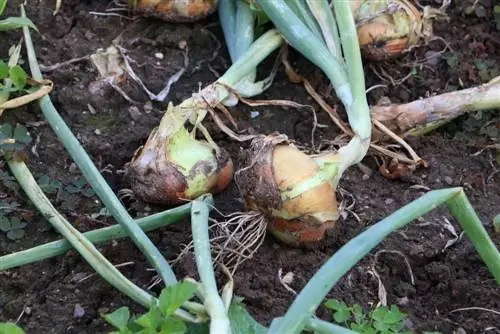- Author admin [email protected].
- Public 2023-12-17 03:39.
- Last modified 2025-01-24 12:45.
Many hobby gardeners don't know when the right harvest time for their pumpkins has come. But there are some indications of fruit ripeness that apply to each pumpkin variety. Once the pumpkin harvest has come in, it is worth storing them properly. The ripening gives the flesh that certain something. Under optimal conditions, butternut, spaghetti squash, etc. can last up to a year.
Note ripening time
When the pumpkin is ripe depends not only on the variety chosen, but also on the weather and when it was planted. The harvest can last from late summer to autumn. The earliest pumpkins are ripe is mid-August. You should have harvested your pumpkin before the first night frosts arrive. Pay attention to the ripening time, as this varies depending on the variety:
- Butternut: 90 to 110 days depending on the variety, harvest time from mid-September to November
- Spaghetti squash: about 100 days, harvest from late August to early November
- Nutmeg pumpkin: between 120 and 150 days, harvest between the end of September and the beginning of November
- Hokkaido: about 95 days, harvest time from September to December
Detecting fruit ripeness
Pumpkins are ripe when their shell is intensely colored. In orange to reddish varieties such as Hokkaido, the final color is particularly easy to recognize. If you have a green variety, the difference between ripening and ripe fruit can only be seen by trained eyes. Therefore, pay attention to the plant. After the fruits are ripe, the annual plant slowly dies off. Their leaves change color. You can harvest the pumpkin when the fruit stalk is woody and dried out. The shell is solid and hard, so it cannot be scratched with a fingernail.
Note:
Many ripe pumpkins sound hollow when tapped. However, this is not a reliable characteristic, because there is often a dull sound before the fruit is ripe or the varieties do not sound hollow at all.
Cutting fruits

Caution is also advised with these robust fruits, as damage can negatively affect their shelf life. It is important that you leave a piece of the stem attached to the fruit. Cut off the pumpkin including a stem about three centimeters long. This means that the pulp is also protected at the base because neither germs nor moisture can penetrate. If the weather is sunny and warm, you can leave the pumpkins outdoors for a few days. Align the support surface upwards or place the pumpkin on its narrow side. This also allows the side facing away from the sun to dry before storage.
Prepare for storage
If dirt sticks to the pumpkins after harvesting, you should remove it with a dry cloth or brush. Avoid washing with water as this can affect durability. Collect the pumpkins one at a time and be careful not to throw them when transporting them. Wooden crates are ideal for transport if your harvest is a little larger.
Allow maturation
If you had to harvest your pumpkins early because of the first night frosts, you should let the fruits ripen. This pre-storage phase lasts around two to three weeks. Store the pumpkin in an airy and warm place at around 20 degrees Celsius. This can be a greenhouse or the windowsill in the kitchen. Place the pumpkin on a piece of newspaper. Ensure there is good air exchange so that the pumpkin cannot absorb moisture and the shell hardens. Check the support regularly and turn the pumpkin every few days. Once it has matured, you can store it properly. If the fruit can continue to ripen after the pumpkin harvest, not only its properties improve:
- Flavor of the pulp improves
- The germination ability of pumpkin seeds increases
- Stem dries completely and protects against infections
Store at the optimum temperature
Correctly ripe pumpkin fruits have a dry, hard shell that protects the pulp for months. If there is no damage, you can store your harvest for several months, depending on the variety. At the storage location, the thermometer should be between twelve and 15 degrees Celsius. If temperatures fall below ten degrees Celsius, the Cucurbita fruits become susceptible to storage rot. Higher temperatures affect the taste.
Pay attention to humidity
Maintain dry conditions and ventilate if necessary. If condensation collects on the shell, it can lead to mold formation if there is poor ventilation. The ideal humidity is a maximum of 60 percent. If stored correctly, you can make full use of the maximum storage life of the pumpkins:
- Hokkaido has a shelf life of five to six months
- Musk pumpkins can be stored for up to a year
- Spaghetti squash can be stored for two to six months depending on the variety
- Butternut lasts up to eight months
Store properly
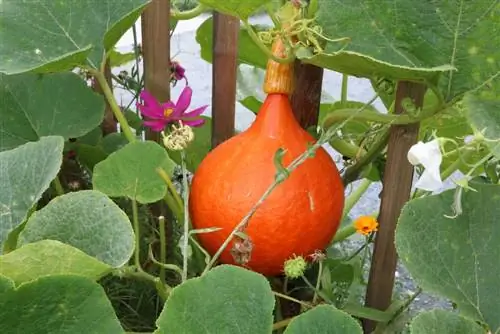
If your cellar offers suitable conditions, you can easily store your harvest in a dark room. If the basement is too damp, you should switch to an unheated and dark storage room. Wooden shelves are ideal. The pumpkins are placed individually on top with a little distance between them. To avoid unsightly pressure marks, you should place cardboard under each pumpkin. Check them regularly for moisture to prevent mold from forming. Potato hordes and storage boxes in which the fruits are stacked on top of each other are not suitable. Optimal ventilation is not guaranteed here and the pumpkins crush each other. If you have to stack your pumpkins due to lack of space, the pumpkin tower should not be more than 80 centimeters high.
Tip:
It is best to store your pumpkin hanging in nets. They are then ventilated from all sides, which prevents mold formation.
Freezer and refrigerator
If the pumpkin has cracks or damage to the shell, you can freeze it as a puree or in small pieces. Except for Hokkaido, all pumpkins are peeled. If you freeze the pulp raw, the he althy ingredients are not lost. The pulp stays fresh in the refrigerator for about three to four days. Cut this into large pieces and wrap them in cling film. The package is stored in the vegetable compartment.
Drying pumpkin
This method is only recommended for small pumpkins. With large fruits like the Halloween pumpkin variety 'Ghost Rider', the pulp cannot dry sufficiently. Very well ventilated storage is important. To do this, the pumpkin is hung on its stem. Warm temperatures and dry air promote the drying process. However, a layer of mold often forms on the outer skin. If it is only superficially moldy and has no rotten spots, you can rub the mold off. The duration of drying depends on the size of the fruit and the environmental conditions.

